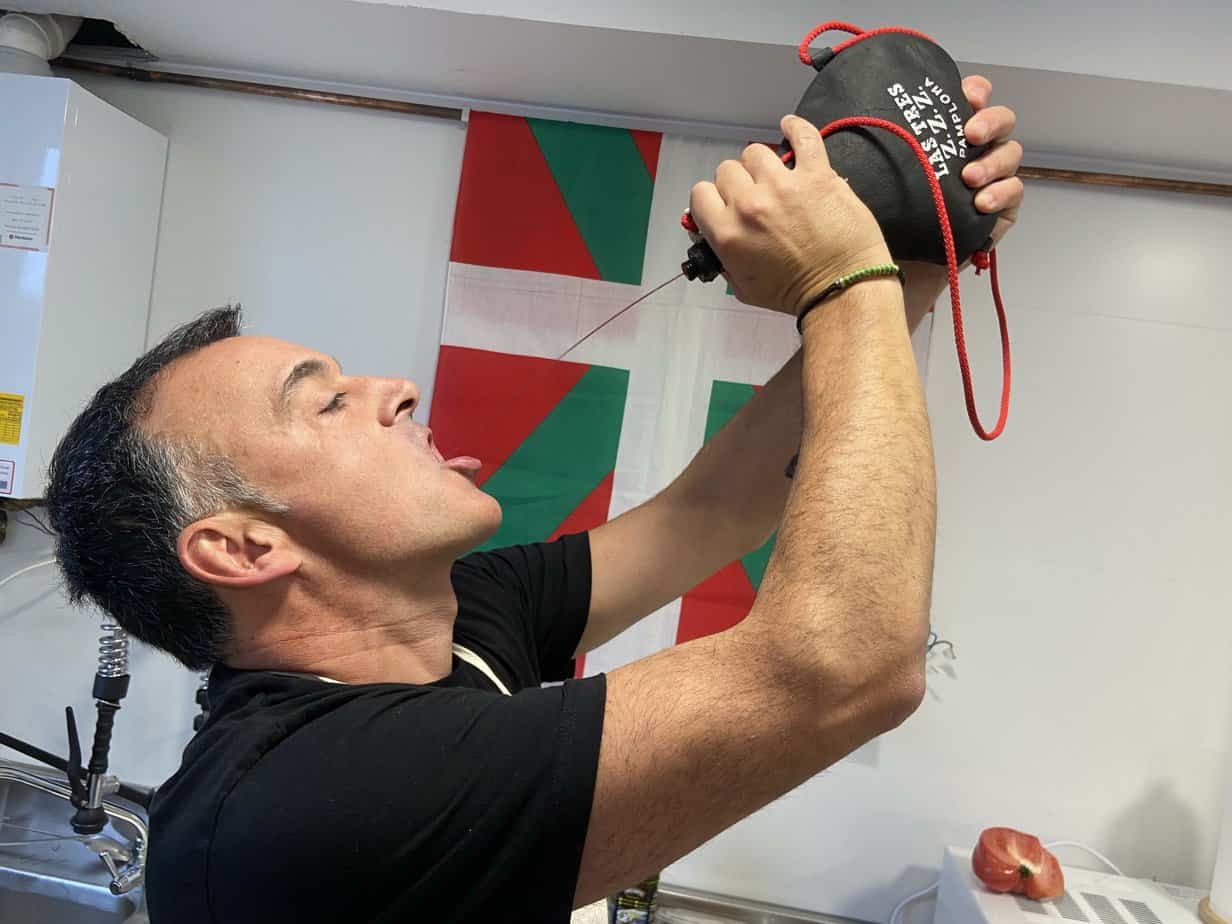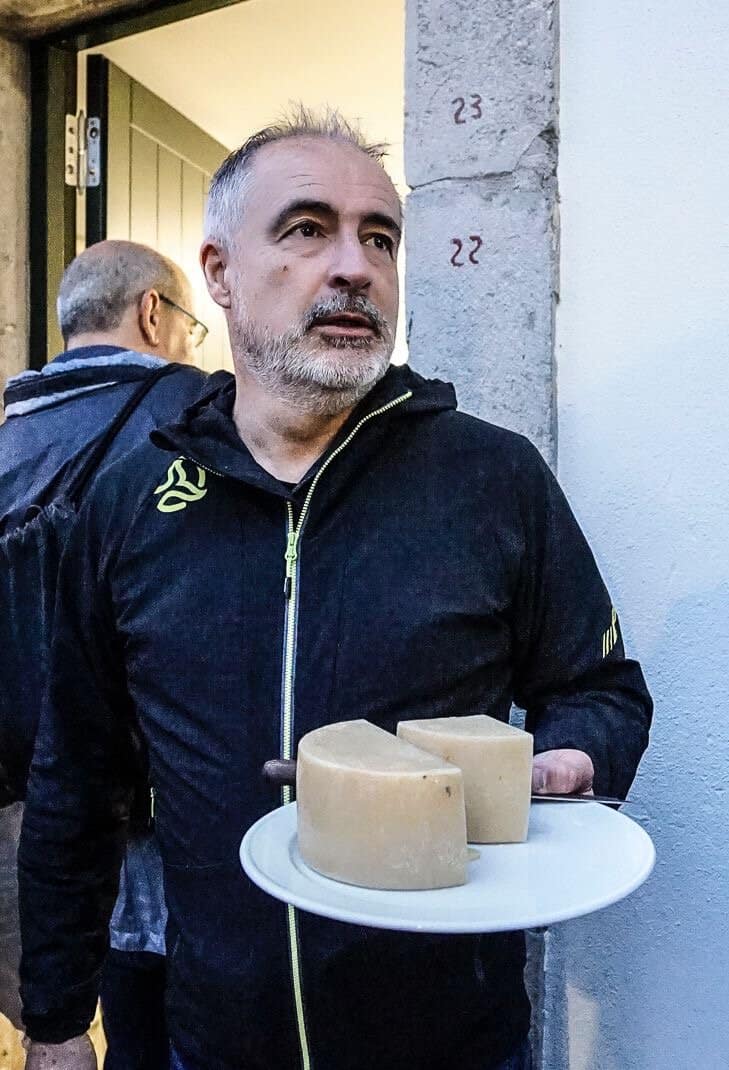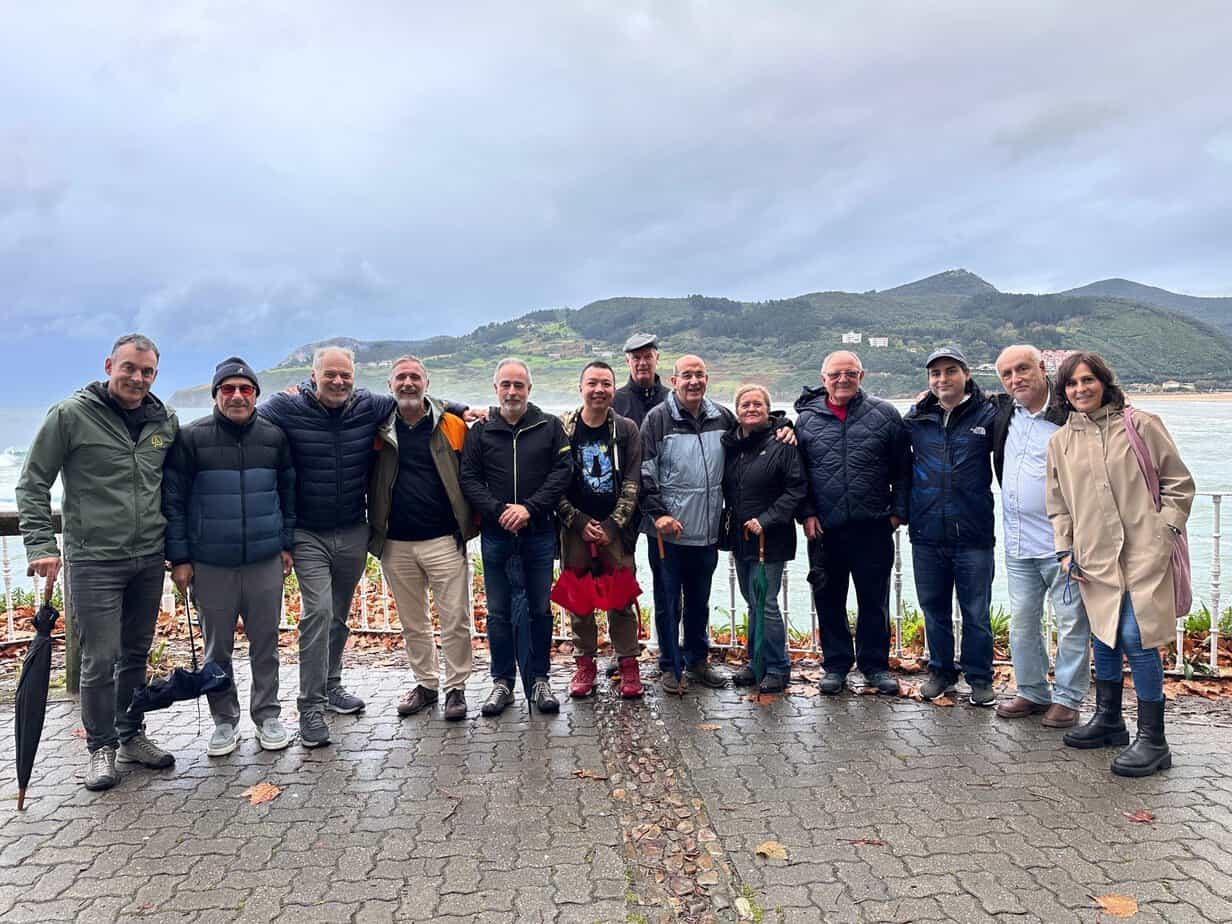Txoko: Basques’ traditional feast a gastronomic peek into a delicious culture

MUNDAKA, Spain – The eight kilograms of steaks sizzled on the grill, filling the small room with crackling sounds like small fireworks and the aroma of roasted caramelized spices. I sat next to a mountainous bowl of calamari and satellite-sized dishes of prawns both big and small.
When one bottle of wine emptied, another freshly opened appeared at my side. Plates of food flew around like Frisbees with so many side dishes I barely had room to place my steak knife.
And where did that €7,000 wheel of cheese go?
Food has been one of my main writing subjects for a long time. I’ve been to countless feasts in many countries. A churrascaria in Brazil. A smorgasbord in Sweden. A wildlife barbecue in Kenya. Here in Italy I get stuffed to my upper molars at Marina’s parents’ every Christmas.
But few places compare with the massive feast Marina and I had in a small coastal village recently in Northern Spain. It was a slice of unique local culture few travelers get to experience. It was like being at the window into a proud people and seeing how they best celebrate their heritage and customs.


Except they see you at the window, invite you in and hand you a steak.
It’s called a txoko. It’s as Basque as jai-alai or wiry pro cyclists in the Pyrenees. But it’s more secretive, more selective and no place during our four days in Basque Country did I see Basque culture at its rawest.
The rare invitation
I came to Bilbao, Spain, in late October for a meeting of my Travelers’ Century Club Mediterranean Chapter. The seven TCC members who attended, all of whom had visited at least 100 countries and territories, getting inside a local culture is our holy grail. It’s what you write home about.
Ricardo Hernani, a Basque from Bilbao and TCC member, picked up Marina, Zhang Deng from Wuhan, China, and me at the Guggenheim Museum and drove us to the sea. We were the invited guests of a local txoko society, a rare occasion for a tradition that dates back more than 150 years.
I knew I was doing a deep dive into Basque culture when I casually told Ricardo that Bilbao is my new favorite city in Spain.
“This is not Spain!” he barked.

Txoko history
In the late 19th century, Northern Spain became heavily industrialized. The Spanish government nationalized mining rights, and iron ore mines and steel works proliferated in Basque Country. The industries attracted more people to the city but when the local bars imposed curfews, locals organized their own spaces.
In 1870 in the Basque city of San Sebastian, the first txoko emerged. It was a place where local men could gather, talk, drink, laugh and, more than anything, cook. Women were not allowed. It was Basque men’s safe haven from women and, eventually, the government.
During Francisco Franco’s dictatorship from 1938-75, the txoko increased in popularity. It was about the only place Basques could freely speak and sing in their banned language without getting jailed or tortured.

The txoko (pronounced CHALK-oh) remains. It’s believed Spain has 1,000-1,500 txokos, the vast majority in Basque Country, a region of Northern Spain barely half the size of Connecticut. The dynamics have changed a bit. About 20 years ago the Basque government began giving txoko societies money – but only if they allowed women. They are now allowed. They just aren’t allowed to cook.
Txokos are also not open to the public. The txoko is no tourist trap. You must be invited by a member of a txoko society. We were lucky.
Ricardo is the brother-in-law of the cook.
“It’s a cult of friendship, time ago between men,” Ricardo said. “Nowadays between people.”

Mundaka
This txako was in the town of Mundaka, a seaside village of 1,800 people on the rugged coast of the Bay of Biscay. After driving 20 miles (37 kilometers) north from Bilbao, we entered Mundaka. Ricardo drove down the narrow windy streets all hugging the broad bay, the day’s rain sparkling on the cobblestones.
We walked past the small harbor packed with boats to a stone jetty. Off in the distance we saw the tiny shapes of about 20 surfers sitting on their boards waiting for the next wave. It was 57 degrees but in the Mundaka surfing scene, temperature is a non-factor.

Mundaka is one of the world’s top surfing destinations. A river flows into the bay, creating waves all year round. It wasn’t long before these surfers we were seeing were all riding waves two meters high. The waves sometimes reach as high as four meters and 400 meters long.
Mundaka was once part of the World Championship Tour of Surfing. Surfing legends Kelly Slater and Andy Irons surfed here. I was cold enough just watching.
We all retreated to the warmth of Tavern La Lenera, a crammed local bar that oozed Basque. From the Basque pelota handball game played on the TV to the soccer jersey of Athletic Bilbao legend Joseba Etxeberria hanging on the wall, Le Lenera was the corner of Basque culture we all sought.

I ordered a glass of Itsas Mendi, a nice local white wine, and chatted with Illan Urkia, the young bartender and son of the owner. Tapas of little hotdogs and sandwiches, all gored with wooden sticks, sat behind glass. It was a friendly group with lots of laughter between lifelong friends. Illan talked about the Basques’ tough times under Franco.
“Now we want to live free and forget,” he said.

Txoko
Txoko comes from zoko, the Basque word for “cozy corner.” And it is. We all gathered at a non-descript door with no sign indicating anything about a unique slice of Basque culture was about to occur. Inside a small room were two long tables with 16 place settings and three bottles of wine on each table.
The Basque red, white and green striped flag was the lone decoration on the wall.

The meal started with the Basque traditional wine pour. We passed around a leather bota bag filled with wine and took turns squeezing a stream of alcohol in our mouths from increasing lengths. Some of it landed on faces, some on shirts, some on the ground. Some of it even landed in our mouths. The Basques seemed to hit their target from across the room.
It’s always a good indicator of your meal when one of the appetizers is cheese priced at €7,000. True.The queso Aguiniga, from the Basque village of the same name, won the gold medal at the 2016-2017 World Cheese Festival over 3,060 other cheeses from 35 countries.
At a recent auction, it sold for, yes, €7,000. Unfortunately, I never tried it. I was too busy eating my way from the bottom of a mountain of food. Here was the txoko’s shopping list:

- 2 kilograms calamari
- 8.5 kilos beef
- 1.5 kilos small prawns
- 1.5 kilos big prawns
- 400 grams ham
- 2 metal tins of local anchoa fish
- 2 kilos Aguiniga cheese
- 2 heads lettuce
- ½ kilo tuna
- 6.2 kilos tomatoes
- 1.5 kilos quince
- 10 liters red wine
- 2 liters white wine
- Eggs

The conversation at our end centered around our TCC’s decision from early in the year to hold our next chapter meeting in April – in Beirut. With half of Lebanon bombed back to the Stone Age, we moved the meeting to the fall and tentatively moved to a more peaceful destination.
Syria.
Apparently, eastern Ukraine was all booked.
Seriously, we are looking at meeting in Damascus with a side trip to Iraq. I just hope we have a feast like we did in Mundaka. My sizzling steak was huge. The shrimp were fat and juicy. They served the calamari in a tantalizing sweet black sauce made with onions and green peppers.

With all of us fat and happy and feeling as Basque as we ever will, Zigor Egia, one of the cooks, got up and sang a traditional Basque song called Hegoak (The Wings) as his fellow countrymen sang along while he pounded the table for emphasis.
It’s about being Basque, about being unique, about how no one can change them.
If I had cut off its wings,
He would’ve been mine
(But) he wouldn’t have left.
Yes, but there you are!
(But) he would’ve no longer
Been a bird!
And for me,
He was a bird that I loved.”


January 4, 2025 @ 5:21 am
Great expose as always Johno!!
January 6, 2025 @ 6:12 pm
Thanks, Robert. Love those little corners of interesting culture.